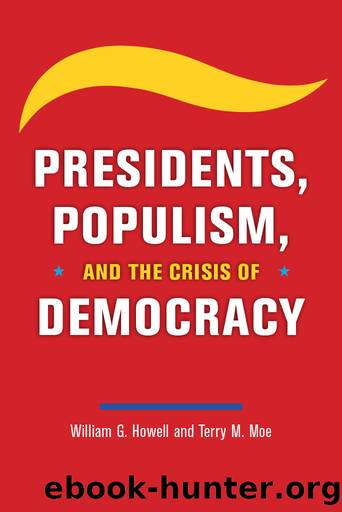Presidents, Populism, and the Crisis of Democracy by William G. Howell & Terry M. Moe

Author:William G. Howell & Terry M. Moe [Howell, William G. & Moe, Terry M.]
Language: eng
Format: epub
Tags: POL000000 Political Science / General
Publisher: University of Chicago Press
Published: 2020-08-10T00:00:00+00:00
Obstacles to Institutional Reform
We arenât Pollyannas about this. We know that changing the Constitution is exceedingly difficult. As the Progressive and New Deal eras well illustrate, the reforms most likely to be adopted in future years are those that can be achieved within the existing constitutional systemâand we will discuss some of the most compelling in the next chapter. Even so, our aim here, first and foremost, is to encourage an understanding of the institutional problem the nation faces: that the Constitution provides a structure of government poorly suited for modern times, and that effective government will continue to be an elusive goal until something is done about it. This being so, it is essential that we face up to the challenge and think it through.
The formal obstacles to amending the Constitution are huge. The standard path is that an amendment must be adopted by two-thirds of the House, two-thirds of the Senate, and three-fourths of the states. An alternative path, which has never been tried, is through ratifying conventions in three-fourths of the states. Either way, there are so many veto points available to opponents that amendment efforts have rarely succeeded. Aside from the Bill of Rights, only seventeen amendments have been adopted throughout the nationâs entire history. Nearly all of these amendments address matters of representation: who gets to participate in elections, how these elections are to be held, and whose interests ultimately hold sway in American politics. Only one amendmentâthe sixteenth, authorizing an income taxâwas designed to modernize the operations of national governance. And it was ratified over a hundred years ago. Meanwhile, not one of these amendments has altered the design of our political institutions and thereby improved the capacity of our government to solve social problems. Not one. In the twenty-first century we continue to live with the framersâ original architecture of 1787.66
The United States now finds itself in crisis. And despite all the dangers associated with this crisisâindeed, because of themâthe prospects for institutional reform are brighter than they have been in a great many years. This feature is true of crises generally, in the United States and elsewhere. They often provide fertile ground for innovation and change. To paraphrase Samuel Johnson, thereâs nothing like a hanging to concentrate the mind.
For real change to occur, however, political forces must be marshaled to overcome the formal obstacles to structural reform. Mobilizing those forces wonât be easy, even in a time of crisis and even if the problem of ineffective government is well understood. The reason is that there are still other obstacles that need to be overcomeâobstacles that are embedded in modern American politics and that shape the dynamics of political power and public support.
Three of these obstacles are particularly important: Constitution worship, polarization, and the Republican Party.
Download
This site does not store any files on its server. We only index and link to content provided by other sites. Please contact the content providers to delete copyright contents if any and email us, we'll remove relevant links or contents immediately.
The Secret History by Donna Tartt(18247)
The Social Justice Warrior Handbook by Lisa De Pasquale(11965)
Thirteen Reasons Why by Jay Asher(8482)
This Is How You Lose Her by Junot Diaz(6466)
Weapons of Math Destruction by Cathy O'Neil(5865)
Zero to One by Peter Thiel(5512)
Beartown by Fredrik Backman(5375)
The Myth of the Strong Leader by Archie Brown(5252)
The Fire Next Time by James Baldwin(5035)
How Democracies Die by Steven Levitsky & Daniel Ziblatt(4973)
Promise Me, Dad by Joe Biden(4916)
Stone's Rules by Roger Stone(4876)
100 Deadly Skills by Clint Emerson(4705)
A Higher Loyalty: Truth, Lies, and Leadership by James Comey(4569)
Rise and Kill First by Ronen Bergman(4555)
Secrecy World by Jake Bernstein(4411)
The David Icke Guide to the Global Conspiracy (and how to end it) by David Icke(4403)
The Farm by Tom Rob Smith(4335)
The Doomsday Machine by Daniel Ellsberg(4255)
